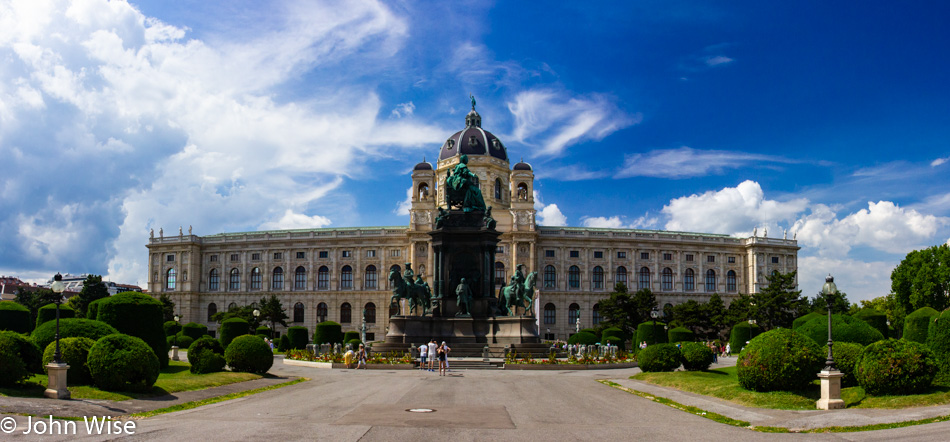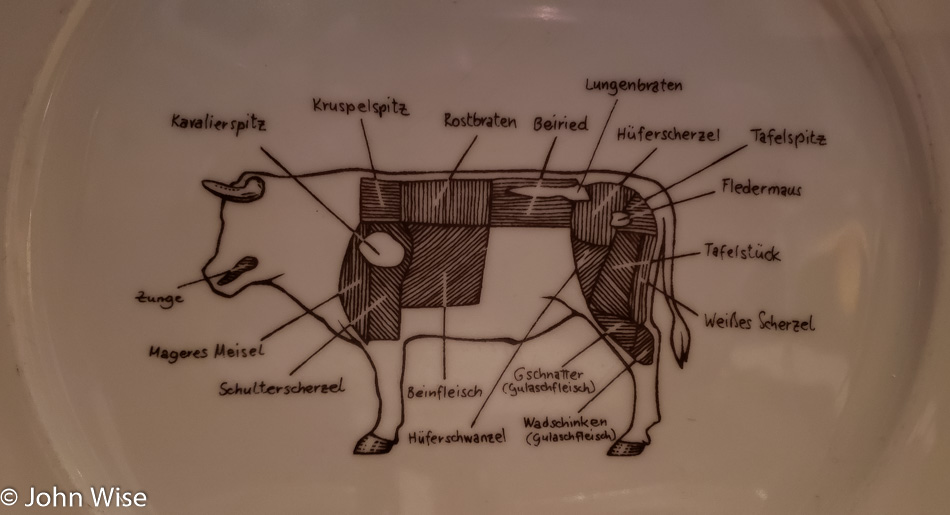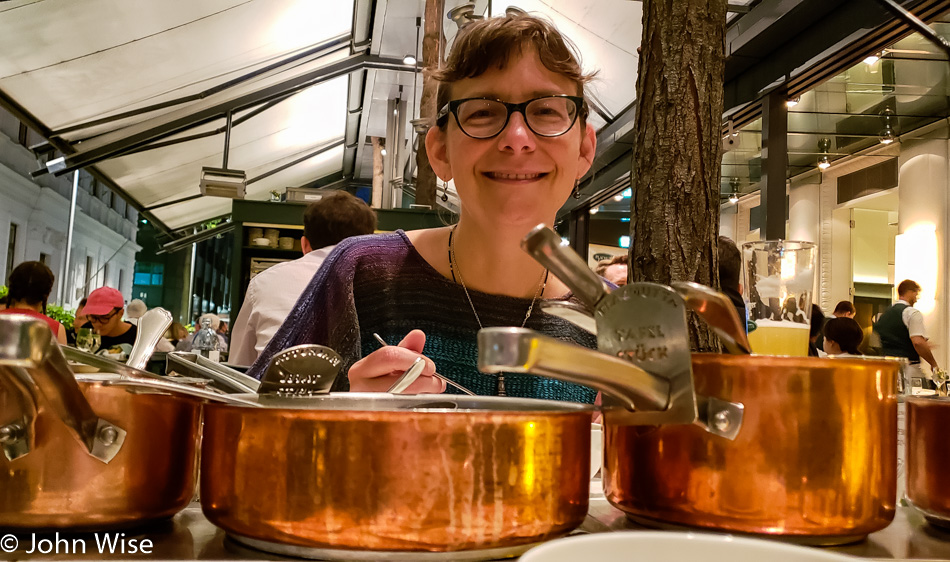
Our day started in the Museumsquartier this morning with breakfast in the courtyard. I’m enjoying our return to European breakfast that does not focus on greasy, hot, and sugary meals that are the norm back home. Mind you that I certainly love my over-medium eggs, bacon, fried potatoes, and even the occasional pancake loaded with melted butter and syrup, but these past weeks of eating various breads, jams, boiled eggs, and occasionally yogurt with some fruit or muesli has been a serious healthy treat. Afterward, we only needed to cross the street to arrive at the Kunsthistorisches Museum.

The entry into the Kunsthistorisches Museum is magnificent and helps set the mood for a visit to grandeur. This European effort to properly astonish a person entering a place that is meant to leave an impression, while effectively implemented in places like Washington D.C. and Disneyland in the United States, is in full effect nearly everywhere we go over here. On the other hand, places like the Grand Canyon, Yellowstone, and Glacier National Park can achieve the same thing with their natural beauty that would be difficult if not impossible to find in much of Europe aside from the Alps, the fjords of Scandinavia, the Wattenmeer in Northern Germany, and the stark volcanic landscape of Iceland. Okay, these kinds of comparisons are stupid, and so I’ll move on now.

Is this a church, a cathedral, a museum, or a superhero masquerading as architecture? This question triggered a wondering out loud about the role environmental aesthetics play in the culture of a population. Let’s take India and Bollywood first. The movies are outrageously colorful and can be known to jump from exotic location to location with no regard for geography. An average movie will have half a dozen large-scale musical productions and fanciful examples of wealth to adorn the romantic aspect of the movie. These three-hour-long fantasy films take the people of India away from reality and the poverty that surrounds many within India.
On the other hand, take the United States and Hollywood. Action heroes, spies, killers, fast cars, and big guns. Ideas of conquering and winning are typically more important than sophistication and opulent splendor of sappy romance and love. The environment and emotions are utilities that only add nuance to the main character and their quest to win.
European film has historically relied upon intrigue, mystery, love, art, schemes, and hints of things behind the scenes that must be teased out of the fabric of history and culture that the narrative is wrapped in.
How much of the cultural needs of these three environments relate to the dominant styles represented in each region’s films? India and an escape from overpopulation and choking poverty, America with open meaningless space that needs to be subdued even with violence if necessary, and Europe with nuance and history found deep within the art, architecture, music, and philosophy? While science is currently a unifying element among our cultures, films about it haven’t proven of any interest aside from the movies that have looked at historical events that surrounded particular milestones.

This brings us to just what it is that is available to be read between the lines, buried in the details, and hidden in plain view that might require something more than the visceral raw emotions to consume a thing. Here at the Kunsthistorisches Museum, in the main area leading to the various exhibitions, is a gallery of sorts that, while not adorned with framed art, still contains a treasure that might be beyond the obvious.

We just so happened to be here at a time when a temporary scaffolding has been erected to allow visitors to get an up-close look at some of the details that were created by Gustav Klimt specifically for this room in the Kunsthistorisches Museum here in Vienna. This work was commissioned a year before the museum opened in 1890 and 10 years before he stopped taking commissioned work following accusations of creating pornography for a ceiling in the Great Hall at the University of Vienna.

Not only are we afforded an up-close and intimate view of Klimt’s work, but we can also glean details of the architecture that we could only get hints of when observed from below.

In the galleries off the center of the museum, we begin to encounter paintings only seen in textbooks, television, and prints in faraway places other than from where the original hangs. Today, we get to walk up to these rarities with the reality that we are here. This closeup is from “Jagdbeute” by Adriaen van Utrecht from roughly 1650.

I’ve never seen this piece from Otto van Veen titled “The Persian Women” before, but fell in love with the idea of these women shaming their men (who had fled from a battlefield) by showing them their pudenda.

From the Flemish master Peter Paul Rubens, we get to peer into his work “The Hunt of Meleager and Atalanta.” If you are interested in a great read about Ovid’s Metamorphoses and the Meleager, Atalanta, and the Calydonian Boar, I’d direct you to read this article on ElecticLight by the author “Hoakley.”

Detail from “St. Luke Painting the Madonna” by Jan Gossaert.

Today, we have maquettes with correct musculature for 3D artists to follow, but 500 years ago, I guess Frans Floris didn’t quite understand proper anatomy when he tackled painting “The Last Judgment.”

Caroline is seen here checking out Pieter Bruegel the Elder’s work titled “The Tower of Babel.” For recognizability, I feel like this work nearly competes with the “Mona Lisa” or “The Death of Marat.”

While we never made it to the cafe here in the Kunsthistorisches Museum, we did have the opportunity to check out some of the architectural details of the floors above the seating area. Elegance would be one word of many that would come to mind in describing this tiny corner in such a grand building.

Art and lots of it to the point of not being able to absorb everything accosting the senses makes us spend a lot of time in museums.

This is me recognizing how much time we’ve spent and how little we’ve seen when visiting a typical museum.

Much of the art and many of the sculptures were once part of the royal collection that was being amassed by the Habsburgs. I wonder what intriguing pieces of art are residing in private collections around the world that are being commissioned from the greatest artisans and craftspeople by the wealthy?

A great example of mandibular prognathism, a birth defect that was a distinguishing characteristic of the later Habsburgs. This protrusion of the lower jaw, which is often accompanied by a thicker lower lip and enlarged tongue, was passed on from generation to generation among the royal family due to a proclivity towards incestuous relationships and breeding.

Direct descendants of the Habsburgs are now extinct, though the name lives on.

This is just one of a thousand pieces of extraordinary stuff on display here that would take a lot more than a mere five hours to explore and truly appreciate.

I’d never seen a “bezoar,” also known as a gastrolith, before today; I didn’t even know they were a thing. These rocks, held inside gastrointestinal tracts, are also known as stomach stones or gizzard stones, depending on their location. Not only were they thought to have magical qualities, but they were considered good for health, too. So, to make a giant specimen into a piece of art, it must have had some serious intention and value behind it.

Tapestry Featuring the Arms of Emperor Charles V, produced under Willem de Pannemaker, Brussels, around 1540. Made of wool, silk, and metal threads.

I’m astonished at this bust of Isabella of Aragon by Francesco Laurana that was sculpted back in 1471 as there is something so lifelike, soft, and tender as though it were a cast made just recently. If I owned this, I’d follow the lines that the sculptor put down just to feel how someone with such an incredible gift might have felt the shape of Isabella’s face as it joined a kind of immortality.

Remember those pieces from Klimt at the beginning of this entry? They were commissioned to bring attention to the Egyptian exhibit that was going to be a permanent part of the collection. We didn’t do justice to seeing anything here, especially the antiquities out of Egypt, as we more or less ran through this part of the museum. What our visit helped cement is that we need to return to Vienna to pay proper tribute not only to this museum but the dozens of other museums we couldn’t visit during our stay.

Across the way opposite the Kunsthistorisches Museum is the Natural History Museum which we did not take the opportunity to visit today, but it is on the list of places to return to. Others on that list include but are not limited to: Vienna Undertakers Museum, Johann Strauss Museum, Schottenstift Museum, Schönbrunn Palace, Österreichische Galerie Belvedere, Museum of Ethnology, Museum of Art Fakes, Liechtenstein Garden Palace, Leopold Museum, KunstHausWien, Haus der Musik, Globe Museum, Chimney Sweep Museum, Beethoven Pasqualatihaus, Arnold Schönberg Center, and the Old Vienna Schnaps Museum to name a few.

Caroline takes a moment to pose with fellow Frankfurter Johann Wolfgang von Goethe. Other than being a literary hero in German-speaking areas, I couldn’t find out precisely what the connection between Goethe and Vienna was.

Welcome to the Imperial Crypt, also known as the Capuchin Crypt. This is the final resting place of 145 members of the House of Habsburg.

This is Emperor Charles VI and the sarcophagus that should house his remains well into the future. Not only was he a Holy Roman Emperor, but he was also King of Bohemia, King of Hungary and Croatia, Serbia, and Archduke of Austria. His coronation was in Frankfurt, Germany, back in 1711.

Veiled face on the sarcophagus of Holy Roman Empress Elisabeth Christine of Brunswick-Wolfenbüttel, German Queen, Queen of Bohemia and Hungary, and Archduchess of Austria by her marriage to Emperor Charles VI.

Tomb of Empress Maria Theresia of Austria with the tomb of Emperor Joseph II in the foreground. Born Maria Theresia Walburga Amalia Christina on 13 May 1717, she was the only female ruler of the Habsburg lands. She was the sovereign of Austria, Hungary, Croatia, Bohemia, Transylvania, Mantua, Milan, Lodomeria, Galicia, the Austrian Netherlands, and Parma. By marriage, she was Duchess of Lorraine, Grand Duchess of Tuscany, and Holy Roman Empress.

Archduchess Maria Theresia Elisabeth Philippine Luise Josepha Johanna was only eight years old when she died in 1770. She was the daughter of Holy Roman Emperor Joseph II. This crypt is a once-in-a-lifetime look into a kind of burial opulence not often seen and rarely done today.

This is the outside of St. Michael’s Church (whose interior was part of yesterday’s blog entry). Fortunately, the need for Sachertorte overcame our need for another visit. Plus, we knew that the Demel would close early, and we were not going to risk missing the tasting of the competing recipe for the most authentic Sachertorte.

So what’s the verdict? The truth is that we both thought the Sachertorte at the Sacher was somewhat better. The torte here at The Demel was a bit dry. Does that make it worse? Not by a long shot, and we would gladly enjoy a slice from either baker at any time. The idea that we are so spoiled to even begin to try both of them is already a privilege not lost on us.

The Schottenkirche or Scots Church is another in a series of splendid churches worthy of a visit. I’m nearing the point where I could say that I’ve never visited a European church I didn’t like.

The Votivkirche, or Votive Church, owes its existence to the attempted assassination of Emperor Franz Joseph in 1853. The Emperor’s brother Archduke Ferdinand Maximilian started the campaign to build the church to thank God for saving the Emperor’s life. The successful assassination of his nephew, Archduke Franz Ferdinand, in 1914 was the spark that started World War I. It was also right here after taking this picture that my foot caught an exposed root and planted me flat in the dirt. With a quickly swelling and bleeding knee and some scraped knuckles, I headed back to our apartment to see if we could find some bandages to tend to my unsightly open wounds.

Patched up with supplies from our Airbnb, with a limp and a bit of pain, we made our way back onto the streets of Vienna.

A peek at one of the Lipizzaner horses in the Spanish Riding School Stables.

A look at the cuts of meat from an ordinary steer printed on the plate of where we are dining tonight. Caroline is pointing out that a lot of the terms are specifically Austrian.

Plachutta claims to have the most famous Tafelspitz in the world, they are most likely correct and not exaggerating a thing. Tafelspitz came to prominence back when Emperor Franz Joseph stated the dish was his favorite meal. There’s an art to eating this, and while the servers are great at helping those of us new to Tafelspitz, their website can show you the art well before you make your reservation. Check it out by clicking here.

It’s just before midnight before we arrive back at our apartment following our two-and-a-half-hour dinner. Now that City Hall is once more bathed in its traditional lighting, we enjoy that we had the chance to see it lit in the many festive colors during the Life Ball. We are in love with Vienna.